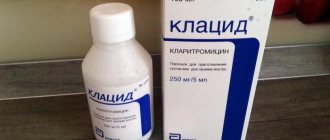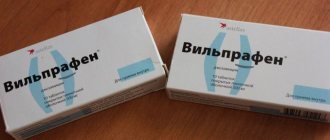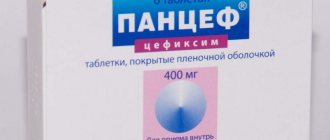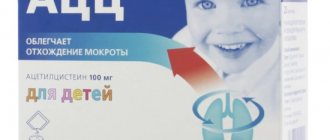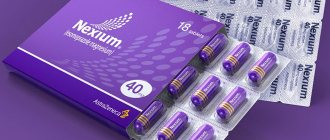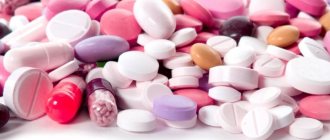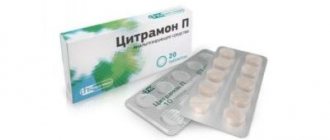Composition, release form and packaging
Granules for the preparation of a solution for oral administration are round, cylindrical or irregular in shape, white, off-white and yellow-green in color.
| 1 pack | |
| ascorbic acid | 50 mg |
| diphenhydramine hydrochloride | 10 mg |
| calcium gluconate monohydrate | 100 mg |
| paracetamol | 250 mg |
| rutoside (in trihydrate form) | 20 mg |
Excipients: citric acid – 30 mg, sugar (sucrose) – 2523 mg, soluble saccharin (sodium saccharin dihydrate) – 12 mg, povidone (polyvinylpyrrolidone K17) – 12 mg.
3 g – sachets (5) – cardboard packs. 3 g – sachets (10) – cardboard packs.
Overdose
In case of excessive use of the drug, characteristic symptoms may appear. Main signs of overdose:
- nausea, vomiting;
- pain in the stomach;
- after 1–2 days of uncontrolled and improper use of the drug: encephalopathy, liver failure, coma.
Treatment is carried out as follows:
- you need to call an ambulance;
- doctors wash the stomach;
- Adsorbents (activated carbon) are prescribed, acetylcysteine and methionine are administered intravenously.
pharmachologic effect
Combined drug.
Paracetamol is an analgesic-antipyretic. It has analgesic, antipyretic and weak anti-inflammatory effects. The mechanism of action is associated with inhibition of prostaglandin synthesis, with a predominant effect on the thermoregulation center in the hypothalamus.
Ascorbic acid is involved in the regulation of redox processes, carbohydrate metabolism, blood clotting, tissue regeneration, and in the synthesis of steroid hormones; increases the body's resistance to infections, reduces vascular permeability, reduces the need for vitamins B1, B2, A, E, folic acid, pantothenic acid. Improves the tolerability of paracetamol and prolongs its effect (associated with prolongation of T1/2).
Diphenhydramine is a first generation histamine H1 receptor blocker that eliminates the effects of histamine mediated through this type of receptor. The effect on the central nervous system is due to the blockade of histamine H3 receptors in the brain and inhibition of central cholinergic structures. It has pronounced antihistamine activity, reduces or prevents smooth muscle spasms caused by histamine, increased capillary permeability, tissue swelling, itching and hyperemia.
Calcium gluconate is a source of calcium in the body, has an antiallergic effect (the mechanism is unclear), prevents the development of increased permeability and fragility of blood vessels, causing hemorrhagic processes during influenza and acute respiratory viral infection, and also restores capillary circulation. For the treatment of allergic diseases or complications, its combined use with antihistamines is recommended.
Rutoside reduces the permeability and fragility of capillaries and has antioxidant properties.
Pharmacokinetic properties
What pharmacokinetic parameters are inherent in Pentaflucin granules?
Instructions for use (the powder should be dissolved before use) states that paracetamol is quickly absorbed from the gastrointestinal tract. Its maximum concentration is reached after approximately 30-55 minutes. It is instantly distributed in tissues and has low protein binding. Paracetamol is metabolized in the liver and excreted by the kidneys. The maximum concentration of rutoside is achieved after 2-9 hours. Its half-life is 10-25 hours.
Ascorbic acid is also quickly absorbed from the gastrointestinal tract. Its highest concentration is achieved after 4 hours. It is metabolized in the liver.
Diphenhydramine, or diphenhydramine, is quickly absorbed into the blood. Its bioavailability is 50%, and the highest concentration is observed after 20-40 minutes. Large amounts of this component are found in the lungs, liver, brain and kidneys. It penetrates the blood-brain barrier, and after a day is completely excreted by the kidneys and through mother’s milk, which often causes a sedative effect in children.
Indications for use
Symptomatic treatment of influenza and other acute respiratory viral infections accompanied by the following symptoms: fever, chills, nasal congestion, sore throat and sinuses, headache, pain in joints and muscles.
Dosage
For oral administration. A single dose is taken 2-3 times a day, depending on age, for 3-5 days. The interval between doses is at least 4 hours. For patients with impaired liver or kidney function
the interval between doses should be increased to 8 hours.
Side effect
Paracetamol
From the digestive system: nausea, epigastric pain.
From the hematopoietic system: anemia, thrombocytopenia, methemoglobinemia, agranulocytosis, hemolytic anemia.
From the skin and subcutaneous tissues: skin rash, itching, urticaria.
From the immune system: angioedema, exudative erythema multiforme (including Stevens-Johnson syndrome, toxic epidermal necrolysis (Lyell's syndrome)) and acute generalized exanthematous pustulosis.
From the respiratory system: bronchospasm in patients sensitive to acetylsalicylic acid and other NSAIDs.
With long-term use in high doses: hepatotoxic and nephrotoxic effects are possible.
Ascorbic acid
From the urinary system: moderate pollakiuria (when taken at a dose of more than 600 mg/day), with long-term use in high doses - hyperoxaluria, nephrolithiasis (from calcium oxalate), damage to the glomerular apparatus of the kidneys.
From the digestive system: irritation of the gastrointestinal mucosa.
From the skin and subcutaneous tissues: skin rash, skin hyperemia.
From the endocrine system: inhibition of the function of the insular apparatus of the pancreas (hyperglycemia, glycosuria).
Results of laboratory and instrumental studies: thrombocytosis, hyperprothrombinemia, erythropenia, neutrophilic leukocytosis, hypokalemia.
Diphenhydramine
From the respiratory system: dryness of the mucous membrane of the nose and throat, increased viscosity of sputum, a feeling of constriction in the chest or throat, sneezing, nasal congestion.
From the nervous system: headache, sedation, drowsiness, dizziness, loss of coordination, weakness, confusion, anxiety, agitation, nervousness, tremor, irritability, insomnia, euphoria, paresthesia, neuritis, convulsions.
From the senses: impaired visual perception, diplopia, vertigo, tinnitus, acute labyrinthitis.
From the digestive system: dryness of the oral mucosa, epigastric pain, anorexia, nausea, vomiting, diarrhea, constipation.
From the urinary system: frequent or difficult urination, urinary retention.
From the reproductive system: early menstruation.
From the hematopoietic organs: hemolytic anemia, thrombocytopenia, agranulocytosis.
Allergic reactions: urticaria, drug rash, anaphylactic shock, photosensitivity
Other: increased sweating, chills.
Calcium gluconate
From the digestive system: constipation, irritation of the gastrointestinal mucosa, nausea, vomiting.
Rutoside
Allergic reactions: skin rash.
From the digestive system: nausea, diarrhea, heartburn.
From the nervous system: headache.
From the cardiovascular system: “flushes” of blood to the face.
Contraindications
Severe dysfunction of the liver, kidneys, angle-closure glaucoma, prostatic hyperplasia, stenosing peptic ulcer of the stomach and duodenum, stenosis of the bladder neck, epilepsy, hypercalciuria, nephrourolithiasis, sarcoidosis, concomitant use of cardiac glycosides, hypercalcemia, hyperoxaluria, pronounced changes in the rheological properties of blood, deficiency of glucose-6-phosphate dehydrogenase, children under 6 years of age, simultaneous use of other medications containing components of this combination, diabetes mellitus (for dosage forms containing sugar).
Carefully
Benign hyperbilirubinemia (Gilbert's syndrome), mild to moderate liver and kidney dysfunction, cardiovascular diseases, hypercoagulation, dehydration, diarrhea, bronchial asthma.
Use during pregnancy
Contraindicated for use during pregnancy and lactation (breastfeeding).
Drug interactions
The use of drugs containing this combination should be avoided in combination with barbiturates, anticonvulsants, phenytoin, carbamazepine, rifampicin, zidovudine and other inducers of microsomal liver enzymes.
Preparations containing this combination are incompatible with alkaline solutions
.
Paracetamol
Reduces the effectiveness of uricosuric drugs
.
Concomitant use of paracetamol in high doses increases the effect of anticoagulants
(decreased synthesis of procoagulant factors in the liver).
Long-term combined use of paracetamol and NSAIDs
increases the risk of developing nephropathy and renal papillary necrosis, and the onset of end-stage renal failure.
Diflunisal
increases the plasma concentration of paracetamol by 50% - the risk of developing hepatotoxicity.
Drugs that cause myelotoxicity
enhance the manifestations of paracetamol hematotoxicity.
Ascorbic acid
Increases the concentration of benzylpenicillin and tetracyclines
;
at a dose of 1 g/day increases the bioavailability of ethinyl estradiol
(including that included in oral contraceptives).
Reduces the effectiveness of heparin and indirect anticoagulants.
Improves absorption of iron preparations
(converts ferric iron to divalent iron);
may increase iron excretion when used concomitantly with deferoxamine
.
Acetylsalicylic acid, oral contraceptives, fresh juices and alkaline drinks
reduce the absorption and assimilation of ascorbic acid.
When used simultaneously with acetylsalicylic acid
The excretion of ascorbic acid in urine increases and the excretion of acetylsalicylic acid decreases. Acetylsalicylic acid reduces the absorption of ascorbic acid by approximately 30%.
Increases the risk of developing crystalluria when treated with salicylates and sulfonamides
short-acting, slows down the excretion of acids by the kidneys, increases the excretion of drugs that have an alkaline reaction (including alkaloids), reduces the concentration of oral contraceptives in the blood.
When used simultaneously, it reduces the chronotropic effect of isoprenaline
.
Diphenhydramine
Potentiates the effect of ethanol and drugs that depress the central nervous system
.
MAO inhibitors
enhance the anticholinergic activity of diphenhydramine.
Reduces the effectiveness of apomorphine
as an emetic in the treatment of poisoning.
Strengthens the anticholinergic effects of drugs with m-anticholinergic activity.
Calcium gluconate
When used simultaneously with quinidine, intraventricular conduction may slow down and the toxicity of quinidine may increase.
Forms insoluble complexes with tetracycline antibiotics
(reduces the antibacterial effect).
Slows down the absorption of tetracyclines, digoxin, and oral iron supplements
(the interval between their doses should be at least 2 hours).
When combined with thiazide diuretics
may enhance hypercalcemia, reduce the effect of calcitonin in hypercalcemia.
Reduces the bioavailability of phenytoin
.
Pharmaceutically incompatible with carbonates, salicylates, sulfates
(forms insoluble or sparingly soluble calcium salts).
Reduces the effect of slow calcium channel blockers.
Rutoside
The pharmacological effect is enhanced by ascorbic acid
.
special instructions
For hyperthermia lasting more than 3 days and pain lasting more than 5 days, a doctor’s consultation is required.
During long-term treatment, monitoring of the peripheral blood picture and the functional state of the liver is necessary.
To avoid toxic liver damage, you should not combine the drug with drinking alcoholic beverages.
Ascorbic acid, as a reducing agent, can distort the results of various laboratory tests (blood glucose, bilirubin, transaminase activity, LDH).
The simultaneous use of other drugs should be agreed with a doctor.
Impact on the ability to drive vehicles and machinery
Drugs containing this combination cause drowsiness and impair reaction speed, so during the treatment period it is necessary to refrain from driving vehicles and engaging in other potentially hazardous activities that require increased concentration and speed of psychomotor reactions.
Pentaflucin for children
In pharmacies you can find this powder intended specifically for children. It differs from the drug for adults by containing fewer active substances. Recommended for use by children over six years of age.
Children from six to ten years old are recommended to take one sachet twice a day. But children who have reached the age of ten need to consume two or three sachets daily. In this case, the interval between the use of the medicine should be at least four hours. Treatment should be carried out for three to five days. If after this period the symptoms of the disease are still present, be sure to consult a doctor.
Price
You can buy the medicine without a prescription. The cost of Pentaflucin may vary, depending on the manufacturer, form of release and specific place of sale. Prices for the drug in different pharmacies in Moscow and the region.
| Form | Pharmacy | Price in rubles |
| Powder 5g No. 10 | Dialogue | 135-140 |
| Preparation 5 pcs. packages 10 sachets | 36,6 | 110 155 |
| Granules 5g No. 10 | IFC | 205-210 |
| Baby powder 3g 10 packets Pentaflucin daily 5g No. 10 | ZdravZone | 120 170 |
| Children's 3g 10 pack. Daily powder 5 g No. 10 | Apteka.RU | 130 190 |

